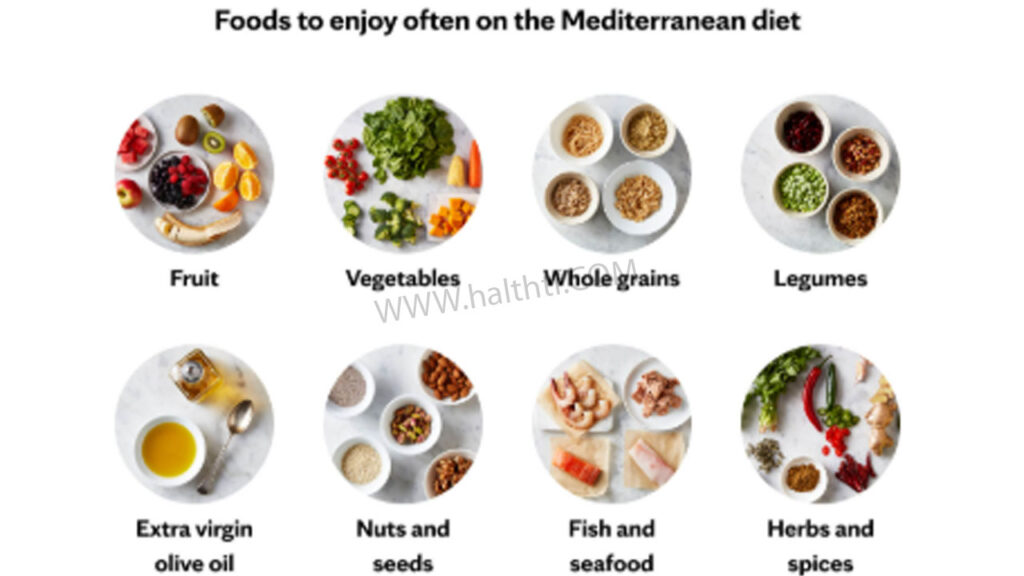Low-Salt Eating Plan: Mediterranean Diet
Considered one of the healthiest eating patterns in the world, the Mediterranean Diet goes low-salt, a double positive for heart health and blood pressure management. This diet, commonly followed in Mediterranean countries bordering the sea, features fresh, healthy foods with natural seasonings rather than heavy salt.

Fundamentally, the Mediterranean Diet is centered around fruits and vegetables, whole grains, legumes, nuts, olive oil and lean proteins, such as fish and poultry. They consume little red meat and few processed foods, and they use olive oil as the primary healthy fat. Dairy is consumed in limited quantities, typically yogurt and cheese.
The low-salt method builds flavor with dried or fresh herbs, spices (including peppers), garlic, onions, citrus juice and vinegar instead of using added salt. This is a colorful and delicious meal, all while controlling your salt intake. In this way, the Mediterranean Diet promotes heart health and reduces the risk of high blood pressure, in addition to helping to manage your weight.
Studies continue to demonstrate that people who adopt this plan have greater longevity and reduced risk of disease. By following a balanced way of eating along with lower sodium and Mediterranean diet, it’s an easy to maintain lifestyle of flavorful health.
Low-Salt Eating Plan: Fresh and Wholesome Mediterranean Foods
In the low-salt iteration of the Mediterranean Diet, is all about knocking back fresh produce, olive oil, fish, legumes, and nuts. Together that makes a meal-plan or pattern of eating that brings nutrients to our bodies and makes our hearts healthy, that is delicious and that is sustainable.
Fresh fruits and vegetables so are also low in sodium, and also give some vitamins, minerals and antioxidants. They bulk up meals, aid in digestion and assist in controlling blood pressure. One of the key ways olive oil benefits your heart is through this anti-inflammatory mechanism.
Fish (especially fatty fish such as salmon, sardines and mackerel) are high in omega-3 fatty acids, which can help protect against heart disease. Beans and lentils (including lentil pastas) as well as chickpeas (also known as garbanzo beans) offer both plant-based protein and fiber, so they’re satisfying and nutritious without the added salt. Nuts and seeds are sources of healthy fats, minerals and energy that come with the rewarding crunch factor, meaning foot could get a break from the usual processed snacky stuff.
With these nutrient-rich foods it eliminates the need for salt to make things palatable. Instead, meals are bright and flavorful — thanks to herbs, spices, lemon and garlic. This low-sodium Mediterranean method of eating is not only good for the heart but encourages a long and healthy life.
Low-Salt Eating Plan: Flavor with Herbs and Spices
One of the best ways to take advantage of food lovingly, while also eating within a low-salt eating plan, is to substitute the salt we add to food with fresh herbs, spices, garlic, lemon, and other flavorings. It is formative to the Mediterranean Diet and is a key way of enhancing the flavor of a meal without the excessive use of sodium.
Herbs like basil, oregano, parsley, rosemary, and thyme impart scent and a sense of depth to food, relaying vegetables, grains and proteins that taste fresh and exciting. Flavors are boosted with cumin, paprika, turmeric, and black pepper, which offer even more health benefits (powerful antioxidants and anti-inflammatory agents)!
Garlic is a powerful natural flavoring agent, to say nothing of it’s health benefits for your heart and blood pressure, making it a fantastic option for low sodium diets. Lemon juice and zest enliven dishes with a perky tang — brightening, enhancing other flavors and diminishing the need for salt. Vinegar and chile flakes can also add bite, or heat, without the added sodium.
By enjoying these natural flavors, meals can be tasty and varied! This is essentially a food centred approach to a low salt life, turning it from something that feels like a restriction into an active and enjoyable lifestyle; making the point that healthy eating can also be heart friendly and tasty!
Low-Salt Eating Plan: Naturally Low in Sodium
Eating a diet made of fresh, whole, unprocessed foods is a healthy way to reduce blood pressure naturally. Highly processed foods (including things like packaged snacks, ready meals, canned soups and fast food) may contain hidden salt that means that before you know it, you’ve already exceeded your recommended limit for the day. And by eliminating these, you automatically drastically reduce excess sodium without even trying.
Whole foods — everything from fruits and vegetables to whole grains, legumes, nuts, lean proteins and plain fresh dairy products — contain little or no natural sodium, but are abundant with vitamins, minerals and fiber. This equilibrium assists the body in managing blood pressure. For instance, potassium-rich foods such as bananas, spinach, legumes, they “basically negate the effect of sodium and promote healthy cardiovascular function.”
When cooking meals at home with fresh ingredients, you also have more control over the amount of salt you use. Instead of prepackaged seasonings or sauces, flavor can be derived from herbs, spices, citrus, garlic or vinegar. Not only does this discourage the consumption of sodium, but it adds appreciable variety and relish to the diet.
One sensitive menace to good health is the all-pervading salt, but by sidestepping the processed and opting for whole, a diet low in salt is as easy as it is beneficial: to begin with your health naturally and beautifully in your kitchen without giving up great food.


